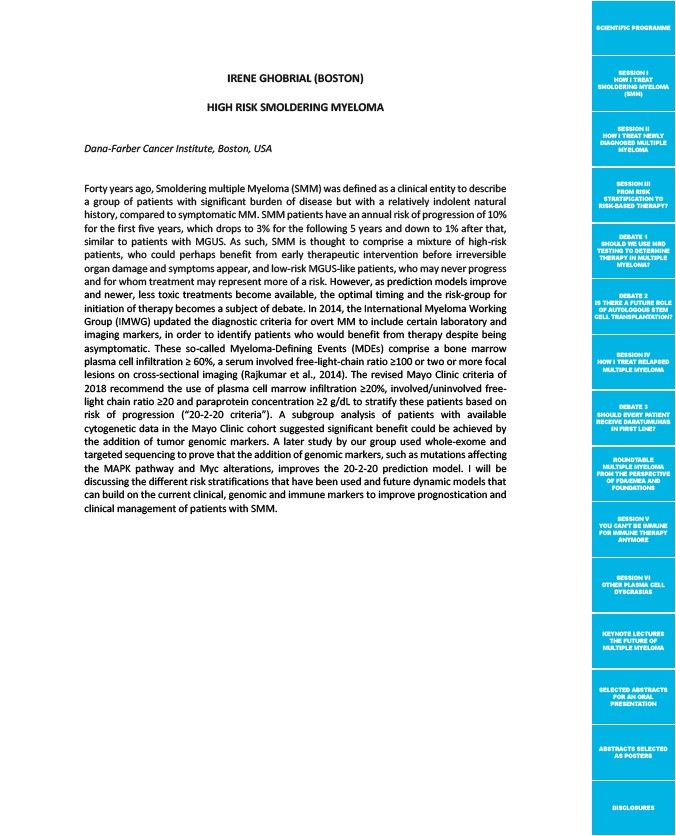
SCIENTIFIC PROGRAMME
SESSION I
HOW I TREAT
SMOLDERING MYELOMA
(SMM)
SESSION II
HOW I TREAT NEWLY
DIAGNOSED MULTIPLE
MYELOMA
SESSION III
FROM RISK
STRATIFICATION TO
RISK-BASED THERAPY?
DEBATE 1
SHOULD WE USE MRD
TESTING TO DETERMINE
THERAPY IN MULTIPLE
MYELOMA?
DEBATE 2
IS THERE A FUTURE ROLE
OF AUTOLOGOUS STEM
CELL TRANSPLANTATION?
SESSION IV
HOW I TREAT RELAPSED
MULTIPLE MYELOMA
DEBATE 3
SHOULD EVERY PATIENT
RECEIVE DARATUMUMAB
IN FIRST LINE?
ROUNDTABLE
MULTIPLE MYELOMA
FROM THE PERSPECTIVE
OF FDA/EMEA AND
FOUNDATIONS
SESSION V
YOU CAN’T BE IMMUNE
FOR IMMUNE THERAPY
ANYMORE
SESSION VI
OTHER PLASMA CELL
DYSCRASIAS
KEYNOTE LECTURES
THE FUTURE OF
MULTIPLE MYELOMA
SELECTED ABSTRACTS
FOR AN ORAL
PRESENTATION
ABSTRACTS SELECTED
AS POSTERS
DISCLOSURES
IRENE GHOBRIAL (BOSTON)
HIGH RISK SMOLDERING MYELOMA
Dana-Farber Cancer Institute, Boston, USA
Forty years ago, Smoldering multiple Myeloma (SMM) was defined as a clinical entity to describe
a group of patients with significant burden of disease but with a relatively indolent natural
history, compared to symptomatic MM. SMM patients have an annual risk of progression of 10%
for the first five years, which drops to 3% for the following 5 years and down to 1% after that,
similar to patients with MGUS. As such, SMM is thought to comprise a mixture of high-risk
patients, who could perhaps benefit from early therapeutic intervention before irreversible
organ damage and symptoms appear, and low-risk MGUS-like patients, who may never progress
and for whom treatment may represent more of a risk. However, as prediction models improve
and newer, less toxic treatments become available, the optimal timing and the risk-group for
initiation of therapy becomes a subject of debate. In 2014, the International Myeloma Working
Group (IMWG) updated the diagnostic criteria for overt MM to include certain laboratory and
imaging markers, in order to identify patients who would benefit from therapy despite being
asymptomatic. These so-called Myeloma-Defining Events (MDEs) comprise a bone marrow
plasma cell infiltration ≥ 60%, a serum involved free-light-chain ratio ≥100 or two or more focal
lesions on cross-sectional imaging (Rajkumar et al., 2014). The revised Mayo Clinic criteria of
2018 recommend the use of plasma cell marrow infiltration ≥20%, involved/uninvolved free-light
chain ratio ≥20 and paraprotein concentration ≥2 g/dL to stratify these patients based on
risk of progression (“20-2-20 criteria”). A subgroup analysis of patients with available
cytogenetic data in the Mayo Clinic cohort suggested significant benefit could be achieved by
the addition of tumor genomic markers. A later study by our group used whole-exome and
targeted sequencing to prove that the addition of genomic markers, such as mutations affecting
the MAPK pathway and Myc alterations, improves the 20-2-20 prediction model. I will be
discussing the different risk stratifications that have been used and future dynamic models that
can build on the current clinical, genomic and immune markers to improve prognostication and
clinical management of patients with SMM.